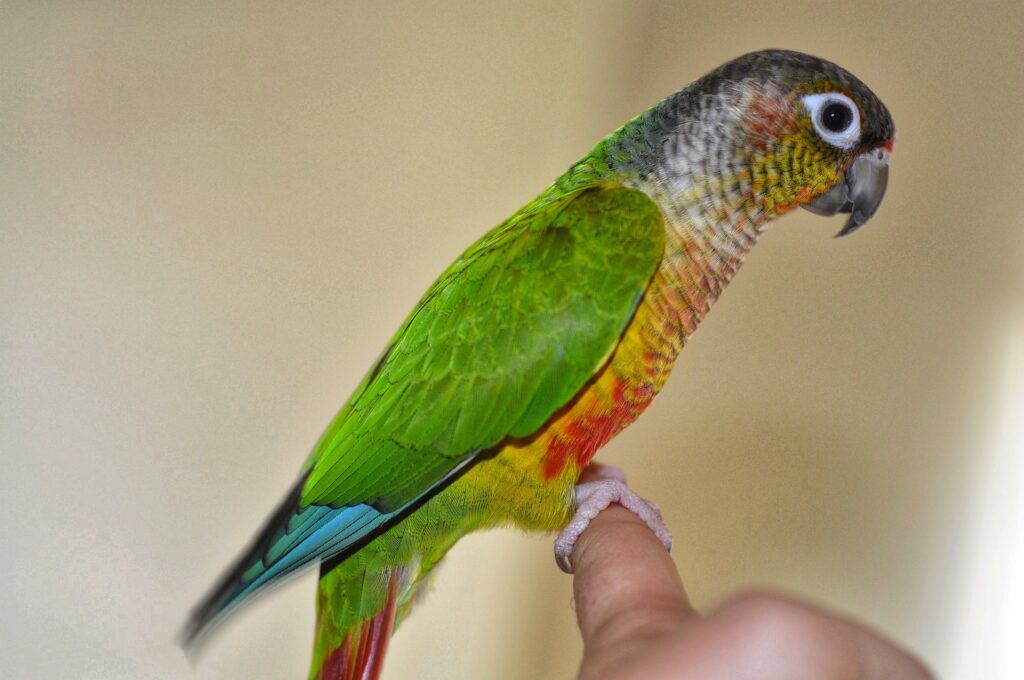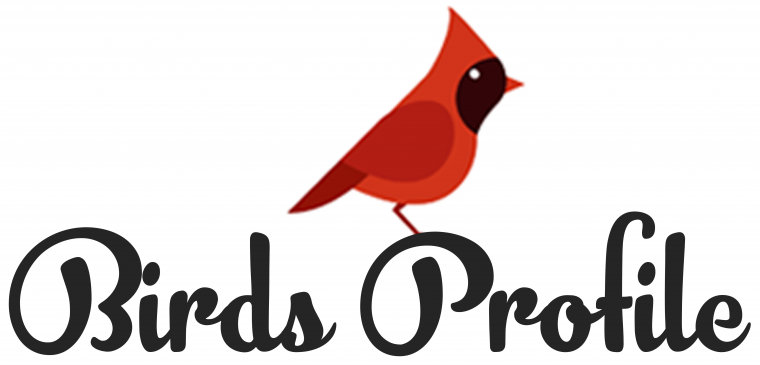Looking to adopt a green cheek conure? Great – you will get the chance to give a bird (or maybe even two!) a friendly home environment!
But before adopting a bird, there are a few important facts that you should know about green cheek conures.
Below are a number of green cheek conure facts that you must keep in mind before adoption. After you are done with this post, you will know exactly what to expect from a green cheek conure and how to take care of it.
Green Cheek Conure Origin
Green cheek conures are first seen in South America. Their home is in the forest. They are mostly found in the forest of Argentina, Bolivia, Brazil, and Paraguay.
Green cheeks typically like to live in flocks of few birds near the treetops. When there’s plenty of food, these birds may live in larger groups as well. Such an amazing creature to look at all together.
The fact that green cheeks live in flocks dictates their high demands for socialization. We’ll be discussing more about it. So stay with us.
Green Cheek Conure Size
Green cheek conures are small birds and are typically sized about 10 inches long. They usually weigh up to about 2.8 ounces.
Due to their similar size and appearance, green cheek conures are often confused with the maroon-bellied conure.
Green Cheek Conure Colors
Green cheek conures are primarily green, but they have:
- Brown, black, and grey crowns.
- Grey beaks.
- Red abdominal areas with short horizontal stripes.
- White rings around the eyes.
- Green cheeks (hence their name).
- Blue primary wing feathers.
- Mostly maroon tails.
Male and female green cheek conures have identical coloring.
Aside from this natural color scheme, there are also other color varieties that have been selectively bred.
Cinnamon green cheek conures have a lime green color and a paler coloring in the feathers. Unlike typical conures, they have a lighter shade of maroon in the tail feathers, while the head is tan.
Pineapple green cheek conures have a bright-colored chest, as well as a tan head and lime feathers on the back (like cinnamon conures).
Yellow-sided green cheek conures sometimes have a bright yellow feather on the upper wing. The yellow coloring is a rare trait and is highly valued by bird owners. And just like the Pineapple green conures they have a bright chest.
Turquoise green cheek conures have beautiful blue-green colored bodies along with green feathers. Unlike other green cheeks, their breast feathers are greyish, while the tails are grey. The wing edges also have bright coloring.

Green Cheek Conure Lifespan
With proper care, green cheek parrots can live up to 30 years, but they usually only live 10 years in captivity due to neglect.
Among factors that may shorten the lifespan of your green cheek conure is stress, neglect, lack of exercise, a poor diet, disease, and proximity to predatory pets. If you want your green cheek conure to live long and happily, then be sure to socialize with it and keep an eye on its health.
Green Cheek Conure Temperament
Green cheek conures are the quietest and the most easygoing of all conures. They are very cuddly as well and like to socialize with their owners. Communication and games are very important for green cheek tenures, so you should only have this bird as a pet if you can dedicate some attention to it.
Conures are more social than cats and perhaps as social as people. This should give you a good idea of how much time and attention you should give your green cheek.
Conures are much more friendly than you think. They generally like to have their necks and heads rubbed, and some may even be so friendly that sometimes they might allow you to flip them onto their backs and rub their tummies. But some individuals may be less inclined to allow rubbing than others.
Green cheeks are so playful. So it’s a must that you place a few toys in your bird’s cage. They like to climb and chew on things as well, so you should make sure that your cage’s furnishing and the cage itself won’t produce any flakes that could harm the bird.
Green cheek conures also like to wrestle with each other and with their owners. It’s thus a good idea to have more than one green cheek to keep the birds occupied. With that said, there are some things to keep in mind when keeping several birds – make sure to research that separately in-depth.
All in all, you should ensure that your bird gets 2-4 hours of outside-cage time for socialization and exercise. These birds live in flocks in the wild, so it’s not a big surprise that they like social contact.
Green Cheek Conure Diet
The diet for green cheek conure is similar to any other parrot species. In captivity, pet green cheek conure should have a diet of seeds, vegetables, fruits, and insects – just like they used to have in the wild. You won’t be able to provide better nutrition with anything other than a fully natural diet.
To keep your green cheek conure healthy, diversify the diet and give a variety of fresh fruits and veggies. You may make a fruit & vegetable salad to make feeding a little bit easier. You could feed your green cheek high-quality pellets as well.
By the way bananas and raisins are the favorite ones on the green cheeks diet list. You can give them as a treat.
These are all-natural foods filled with vitamins and proteins. If the natural foods mentioned above are available for them, then there’s no need for the extra vitamin to add. They will be totally fine and healthy having those around them.
Green Cheek Conure Price
The normal green cheek conure’s price is around $150 to $350 if you want to get it from a private breeder. And for the other varieties including the rare ones may go up to $500.
The price of a green cheek conure varies depending on the variation, size, color, and place as well. You may have to pay much higher if you want to buy from a pet store instead of a private breeder. So, I recommend doing some research before buying your pet bird.
Just to remind you that, along with your pet green cheek they need a good cage and lots of stuff inside it. which will take extra costs.
Green Cheek Conure Cage Size
When it comes to cages, green cheek conures should be at least housed in cages that are 24 inches in width and depth and about 30 inches high. The cage bars should be spaced from 1/2 to 3/4 inches.
Check out the best cages if you are interested to buy one.
A good cage is always recommended for a green cheek conure. The bigger the size of the cage, the better for your bird both physically and mentally as well. But needless to say, when it comes to cage size, you will have to remember two possible limiting factors – your budget and available space.
Just to let you know that bar spacing of a cage for green cheek conure is very important, here’s why :
- If the bar spacing is too narrow, then the bird may feel constrained in the cage. Likewise, you won’t be able to see the bird as easily. With narrowly-spaced bars, it’s also more likely that your bird’s wings, tail, or other body parts will get stuck between the bars.
- If the bar spacing is too wide, then your green cheek conure may be able to escape the enclosure. Even if the bird doesn’t manage to escape, it might get stuck between the bars.
Aside from these, it would be nice if your bird’s cage was:
- Square or rectangular because round cages are difficult to clean, as well as are typically small and low-quality. Aside from that, the bars that meet at the top of the cage might trap your bird.
- Ideally, the cage should be made of stainless steel. This material has excellent durability and doesn’t chip, therefore being safe for birds. Powder-coated steel is a good alternative, but it’s not as durable.
Since green cheek conures love to climb, you should place a few perches in the cage as well. The perches should be at least 9 inches long and half an inch in diameter. You may provide the bird with perches of different sizes to allow for some better exercise.
Another great idea would be to get a birdcage with a play gym on top – during the out-of-cage time, this simple accessory would provide great exercise opportunities for your bird.
Green Cheek Conure Common Health Problems
There’s no bird that can be found that is free from health problems. One of the common problems of Green cheek conure is feather picking. They are prone to that. Fortunately, if you give the bird sufficient attention, this is unlikely to happen. Conures generally pick their feathers when bored or neglected.
Needless to say, this is yet another reason not to adopt a pet green cheek if you won’t be able to socialize with them.
Green cheek conures may also catch some common parrot diseases, such as the fatal psittacine beak and feather disease (PBFD), proventricular dilatation disease (PDD), beak misalignment, or malocclusion. Fungal and bacterial infections are also included in the common health problems of green cheek conures.
Ideally, you should do preventative check-ups with a vet often. Not only that but if your green cheek exhibits unusual behavior, then you should again take it to a vet – if there is indeed anything wrong, then acting quickly will allow for easier treatment.
Can You Ever See Green Cheek Conure Talking?
Yes, you can but not as expected. Talking ability isn’t usually what green cheek conures are sought for. Moreover, they are valued because they are not loud and don’t make much noise throughout the day. They are much calmer than other conure species.
It can be possible for a green cheek conure to talk, but they generally can learn only a few words. Pretty much, talking ability depends on every individual’s personal talent. They might pick up frequently heard words, but don’t expect much from this bird in terms of talking.
You are going to have a hard time making your green cheek talk, but don’t expect clear voices to come out. Because these birds have very soft tones and lower voices, unlike other parrots.
Watch this video to know more about Green Cheek Conure.
Final Words
Our quick green cheek conure facts should help you get started with this gorgeous conure species.
If you want a quieter and friendlier bird, then a green cheek is an excellent choice. But do remember that these conures demand a lot of attention, so be sure that you’ll be able to dedicate 2-4 hours a day to your bird.
Don’t forget other important points as well considering diet, exercise, and caging. We suggest that you read in-depth care guides on green cheek conures too to get a full idea of what to expect with this bird species.
Please feel free to share if you find this helpful.

